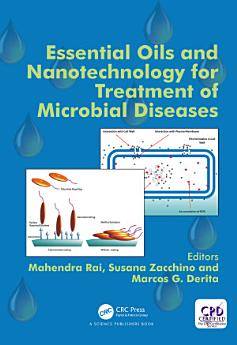Essential Oils and Nanotechnology for Treatment of Microbial Diseases
About this ebook
Essential oils (EOs) are volatile, natural, aromatic oily liquids that can be obtained from several parts of plants especially the aerial ones such as leaves and flowers. They are derived from complex metabolic pathways in order to protect plants from diverse pathogenic microorganisms. In fact, the bioactivity of EOs have been confirmed by several studies which have demonstrated their antibacterial, antiviral, anti-inflammatory, antifungal, antimutagenic, anticarcinogenic, and antioxidant properties.
Nanotechnology is one of the most important and emerging technologies, which has brought about a technological revolution in the world. It has enormous applications in the field of medicine. Nanoparticles are very important tools in curing different diseases in general and microbial diseases in particular due to their significantly novel and improved chemical, physical and biological properties and high surface area-to-volume ratio. Among these, metal nanoparticles are known to play pivotal role in various biomedical applications. In this context, nanoparticles such as silver have shown their potential and could emerge as the new generation of antimicrobials. Silver nanoparticles have broad-spectrum biological activities and hence are used in many biomedical applications. The various biomedical applications of silver nanoparticles include treatment of wounds, burns, in water-disinfecting systems, in nanobased bone implantations, in dentistry for the development of dental materials and as antibacterial, antivirals, anti-protozoals, anti-arthropods and anticancerous agents. Apart from silver, noble metal nanoparticles like gold and platinum and other nanoparticles copper, oxides of different metals, etc. have been also the materials of choice for many scientists for their biological applications.
The book will be of interest to chemists, microbiologists, biotechnologist, food technologists, nanotechnologists, pharmacologists, clinicians and those interested in nature cure. Students will find this book useful and reader friendly.
About the author
Dr. Mahendra Rai is employed in the Laboratory of Biological Chemistry, at the Institute of Chemistry, University Campinas.
Professor Susana Zacchino is employed in the Pharmacognosy Area of the School of Pharmaceutical and Biochemical Sciences at the National University of Rosario.
Dr. Marcos Derita is employed in the area Cultivos Intensivos, at the Facultad de Ciencias Agrarias, Universidad Nacional del Litoral and Area Farmacognosia at the Facultad de Ciencias Bioquimicas y Farmaceuticas at the Universidad Nacional de Rosario.








